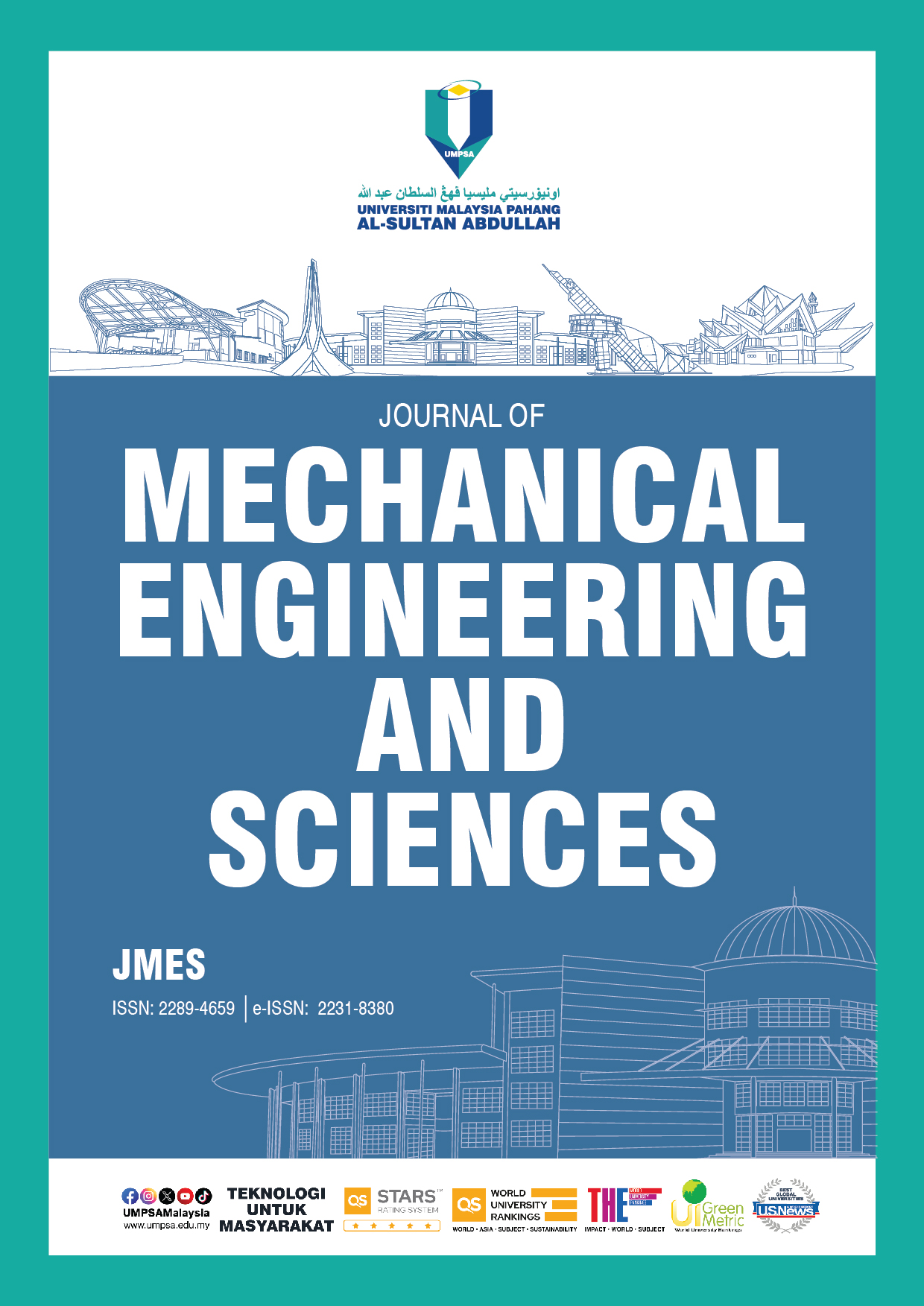Design and analysis of strut-based lattice structure cranial implant
DOI:
https://doi.org/10.15282/jmes.17.1.2023.1.0735Keywords:
Cranioplasty, Cranial implants, Lattice structures, Computational modelling and analysis, PorosityAbstract
A specialized medical cranioplasty procedure entails the use of implants of various materials, forms, and sizes. Computational technologies such as modelling and simulation, have refined the technique for creating these implants catering to patient specific needs. Superior qualities of lattice structures have considerable usage in implants. This study mainly focuses on three distinct types of strut-based lattice structures, Octet, Diamond, and Kelvin, for constructing cranial implant models using CAD tools like Solidworks and nTopology. Titanium alloy (Ti6Al4V) is used to test the behaviour of the designed implants in two cases: impact of external force and increase in intracranial pressure. Level of porosity is compared to determine extent of porosity of these implants, as porosity is significant in osseointegration. According to the study, these lattice structures give satisfactory results and can be utilized to make the implant more porous while satisfying the load bearing capacity.
References
A. Alkhaibary, A. Alharbi, N. Alnefaie, A. Aloraidi, and S. Khairy, “Cranioplasty: A comprehensive review of the history, materials, surgical aspects, and complications,” World Neurosurgery, vol. 139, pp. 445–452, 2020.
B. A. Khader and M. R. Towler, “Materials and techniques used in cranioplasty fixation: A review,” Material Science and Engineering, vol. 66, pp. 315–322, 2016.
A. M. Shah, H. Jung, and S. Skirboll, “Materials used in cranioplasty: A history and analysis,” Neurosurgical Focus, vol. 36, no. 4, p. E19, 2014.
S. Aydin, B. Kucukyuruk, B. Abuzayed, S. Aydin, and G. Z. Sanus, “Cranioplasty: Review of materials and techniques,” Journal of Neurosciences in Rural Practice, vol. 2, no. 2, p. 162, 2011.
A. du Plessis et al., “Properties and applications of additively manufactured metallic cellular materials: A review,” Progress in Material Science, vol. 125, p. 100918, 2022.
B. Otsuki, M. Takemoto, S. Fujibayashi, M. Neo, T. Kokubo, and T. Nakamura, “Pore throat size and connectivity determine bone and tissue ingrowth into porous implants: Three-dimensional micro-CT based structural analyses of porous bioactive titanium implants,” Biomaterials, vol. 27, no. 35, pp. 5892–5900, 2006.
L. P. Lefebvre, J. Banhart, and D. C. Dunand, “Porous metals and metallic foams: current status and recent developments,” Advanced Engineering Materials, vol. 10, no. 9, pp. 775–787, 2008.
K. Moiduddin, S. Darwish, A. Al-Ahmari, S. ElWatidy, A. Mohammad, and W. Ameen, “Structural and mechanical characterization of custom design cranial implant created using additive manufacturing,” Electronic Journal of Biotechnology, vol. 29, pp. 22–31, 2017.
N. Sharma, D. Ostas, H. Rotar, P. Brantner, and F. M. Thieringer, “Design and Additive Manufacturing of a Biomimetic Customized Cranial Implant Based on Voronoi Diagram,” Frontiers in Physiology, vol. 12, p. 647923, 2021.
O. Bittredge et al., “Fabrication and optimisation of Ti-6Al-4V lattice-structured total shoulder implants using laser additive manufacturing,” Materials, vol. 15, pp. 3095, 2022.
H. Gu, M. Pavier, and A. Shterenlikht, “Experimental study of modulus, strength and toughness of 2D triangular lattices,” International Journal of Solids and Structures, vol. 152–153, pp. 207–216, 2018.
D. Rosen, S. Johnston, M. Reed, and H. Wang, “Design of general lattice structures for lightweight and compliance applications,” Proceedings of the Rapid Manufacturing Conference, 2006.
T. C. Dzogbewu, “Additive manufacturing of porous ti-based alloys for biomedical applications-a review,” Journal for New Generation Sciences, vol. 15, no. 1, pp.278-294, 2017.
L.J. Gibson and M.F. Ashby, Cellular solids: Structure & properties, 2ndEdition, Cambridge University Press, 1997.
K. M. Park, K. S. Min, and Y. S. Roh, “Design optimization of lattice structures under compression: study of unit cell types and cell arrangements,” Materials, vol. 15, p. 97, 2021.
K. G. Mostafa, G. A. Momesso, X. Li, D. S. Nobes, and A. J. Qureshi, “Dual graded lattice structures: generation framework and mechanical properties characterization,” Polymers, vol. 13, no. 9, p. 1528, 2021.
C. Pan, Y. Han, and J. Lu, “Design and optimization of lattice structures: A review,” Applied Sciences, vol. 10, no. 18, p. 6374, 2020.
T. Maconachie et al., “SLM lattice structures: properties, performance, applications and challenges,” Materials and Design, vol. 183, p. 108137, 2019.
Y. Tang, G. Dong, Q. Zhou, and Y. F. Zhao, “Lattice structure design and optimization with additive manufacturing constraints,” IEEE Transactions on Automation Science and Engineering, vol. 15, no. 4, pp. 1546–1562, 2018.
K. Moiduddin, S. H. Mian, U. Umer, and H. Alkhalefah, “Fabrication and analysis of a Ti6Al4V implant for cranial restoration,” Applied Sciences, vol. 9, no. 12, p. 2513, 2019.
T. C. Dzogbewu, “Laser powder bed fusion of Ti6Al4V lattice structures and their applications,” Journal of Metals, Materials and Minerals, vol. 30, no. 4, pp. 68–78, 2020.
P. Marcián, N. Narra, L. Borák, J. Chamrad, and J. Wolff, “Biomechanical performance of cranial implants with different thicknesses and material properties: A finite element study,” Computers in Biology and Medicine, vol. 109, pp. 43–52, 2019.
J. Maciejewska and H. Jopek, “An analysis of the Auxetic cranioplasty implant," Vibrations in Physical Systems, vol. 31, no. 3 p. 2020315, 2020.
V. P. Bogu, Y. Ravi Kumar, and A. K. Khanara, “Modelling and structural analysis of skull/cranial implant: beyond mid-line deformities,” Acta of Bioengineering and Biomechanics, vol. 19,no. 1, pp. 125–131, 2017.
Downloads
Published
Issue
Section
License
Copyright (c) 2023 Universiti Malaysia Pahang Publishing

This work is licensed under a Creative Commons Attribution 4.0 International License.






